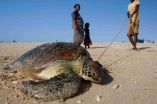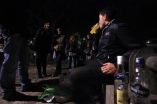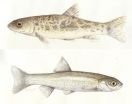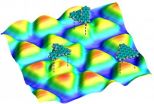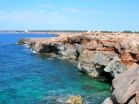(Press-News.org) New research has revealed up to 16,000 endangered turtles are being caught each year by villagers in just one region of Madagascar, despite a government ban.
Researchers from the University of Exeter and Blue Ventures Conservation say the figure, thought to be a conservative estimate, is the first direct assessment of turtle exploitation on the island.
The study highlights the extent of small-scale fishing, traditionally very difficult to monitor, and could be vital in finding a way to sustainably manage turtle fishing in the region.
Dr Annette Broderick, from the Centre for Ecology and Conservation (Cornwall) at the University of Exeter, said: "We conducted this study because we know this small-scale, artisanal fishing is going on despite it being illegal to catch turtles under Malagasy law.
"Because turtles are an endangered species, it's important for us to know what's going on in the region so we can work with the local community to find a sustainable way forward."
Traditionally it has been very difficult and expensive to get data on small-scale, artisanal turtle catch because of the difficulty of access to these remote areas.
This research used a new approach, involving locals in the process by paying a village representative to document each turtle caught, including taking a picture of each one.
Frances Humber, who works for Blue Ventures Conservation, said: "Catching turtles for their meat is an important part of Malagasy culture for many coastal people, but the villagers also understand the importance of ensuring the future of this resource.
"This study is a great way of involving communities in the process of finding a sustainable way forward. Obviously we can't be sure every turtle catch is reported, so we view the figures from this study as a conservative estimate which is still nevertheless very valuable for informing policy."
The research monitored the harvest of marine turtles at 12 coastal villages in Madagascar and documented a total of 699 marine turtle landings, including four species – with the majority being green turtles.
Combining these data with those from previous studies in the region produced a conservative estimate of annual turtle catch in the south-western province of Madagascar of between 10,000 and 16,000.
Frances Humber admits the figures from this study are a cause for concern, but insists Madagascar should not be singled out.
"We'd expect similar harvests in many countries in the tropical coastal developing world, so this isn't an isolated issue, but clearly it is a cause for concern when dealing with endangered species," she said. "It's possible the model for this study could be used elsewhere to get a better idea of numbers.
"Until we get more details, it's difficult to draw conclusions about what is sustainable and how we can find solutions. Clearly making turtle fishing illegal hasn't worked, so we need to work with communities to promote sustainable practices."
The research is due to be published in Animal Conservation.
INFORMATION:
Editors' notes
Blue Ventures is an award winning marine conservation organisation dedicated to conservation, education and sustainable development in tropical coastal communities. You can find out more at
Thousands of turtles captured in Madagascar despite ban
2010-11-12
ELSE PRESS RELEASES FROM THIS DATE:
Study points to window of opportunity for successful autism therapy
2010-11-12
"The biggest surprise to me was that we could rescue the autistic phenotype [in the human cells] to something close to normal," said Alysson Muotri of the University of California San Diego.
The researchers made the discovery by first transforming adult cells taken from patients with Rett Syndrome into induced pluripotent stem cells (iPS cells) using an established cocktail. iPS cells look and act very much like embryonic stem cells.
Those stem cells were able to form functional neurons in cell culture. However, neurons derived from Rett Syndrome patients exhibited ...
A long history of pain: Study finds pain gene common to flies, mice and humans
2010-11-12
They show that one of those genes in particular has a long evolutionary history, as evidenced by the fact that it plays a role in pain sensing in flies, mice and humans. At least in mice, the newly described gene is also linked to a condition known in humans as synesthesia, in which one sensory experience triggers the perception of another sense.
"We found lots of new genes and pathways that have never been implicated in pain before," said Josef Penninger of the Institute of Molecular Biotechnology of the Austrian Academy of Sciences.
"From a helicopter view, this ...
23 percent of young people get into fights when they go out at night
2010-11-12
Night-time violence among young Spaniards is becoming ever more common, according to a research study carried out by the European Institute of Studies on Prevention. The study shows that 5.2% of young people carry weapons when they go out at night, 11.6% have been attacked or threatened, and 23% have got into a fight at some time.
"Reports about young people being attacked or injured in fights when they go out at night are becoming increasingly common", Amador Calafat, lead author of the study and a researcher at the European Institute of Studies on Prevention (IREFREA), ...
Invasive species -- the biggest threat to fish in the Mediterranean basin
2010-11-12
An international team led by the Forest Technology Centre of Catalonia has carried out the first large-scale study of the threats facing freshwater fish in the Mediterranean basin. Invasive species, along with over-exploitation of water resources, are the most important pressures, and those that expose fish to the greatest risk of extinction.
"The continental fish of the Mediterranean basin are one of the most threatened biological groups in the world", Miguel Clavero, lead author of the study and a researcher from the Landscape Ecology Group of the Forest Technology ...
Scientists at IRB Barcelona and BSC publish the world's largest video data bank of proteins
2010-11-12
After four years of conducting intensive calculations in the supercomputer MareNostrum at the Barcelona Supercomputing Center, scientists headed by Modesto Orozco at the Institute for Research in Biomedicine (IRB Barcelona) have presented the world's largest data base on protein motions. Called MoDEL, this new database holds more than 1,700 proteins and is partially accessible through Internet to researchers worldwide. MoDEL has been developed to study the basic biology of proteins and to accelerate and facilitate the design of new pharmaceutical agents.
"Nowadays we ...
UT professors find mixing business with politics pays off
2010-11-12
Now that the 2010 election is over, here is something to consider for the 2012 race: If you want to fatten your company's profits, contribute to a political campaign.
A study by two College of Business Administration professors at the University of Tennessee, Knoxville, found that when firms engage in corporate political activities, such as lobbying and making campaign contributions, they enjoy about 20 percent higher performance. The study, by Russell Crook and David Woehr, along with Sean Lux of the University of South Florida, entitled "Mixing Business with Politics: ...
Teens' take on bullying
2010-11-12
Both the bully and the victim's individual characteristics, rather than the wider social environment, explain why bullying occurs, according to Swedish teenagers. The new study, by Dr. Robert Thornberg and Sven Knutsen from Linköping University in Sweden, also shows that 42 percent of teenagers blamed the victim for the bullying. The study is published online in Springer's journal, Child & Youth Care Forum.
In one of the rare studies investigating young people's views on why bullying takes place in school, Thornberg and Knutsen explored how teenagers explain bullying ...
Step by step toward tomorrow's nanomaterial
2010-11-12
Electronic components are getting smaller and smaller, with microelectronic components gradually being replaced by nanoelectronic ones. On nanoscale dimensions, silicon, which is at the present stage the most commonly used material in semiconductor technology, reaches however a limit, preventing further miniaturization and technological progress. New electronic materials are therefore in great demand. Due to its outstanding electronic properties, graphene, a two-dimensional carbon network, is considered as a possible replacement. However, several obstacles must be overcome ...
Circuitry of fear identified
2010-11-12
Fear arises in the almond-shaped brain structure known as the amygdala. It is the amygdala which processes the strange noise, shadowy figure or scary face and not only triggers palpitations or nausea but can also cause us to flee or freeze. That much has long been known about the function of this part of the brain. What remains largely unclear, however, is precisely how fear develops, and which of the countless neurons in the amygdaloid region are involved in this process. But finding answers to these questions is vital for those who wish to improve the quality of life ...
African dust caused red soil in southern Europe
2010-11-12
Spanish and American researchers have conducted a mineralogical and chemical analysis to ascertain the origin of "terra rossa" soil in the Mediterranean. The results of the study reveal that mineral dust from the African regions of the Sahara and Sahel, which emit between 600 and 700 tonnes of dust a year, brought about the reddish soil in Mediterranean regions such as Mallorca and Sardinia between 12,000 and 25,000 years ago.
"The first hint of the relationship between African dust and certain soils in the region of the Mediterranean is their reddish or reddish-brown ...
